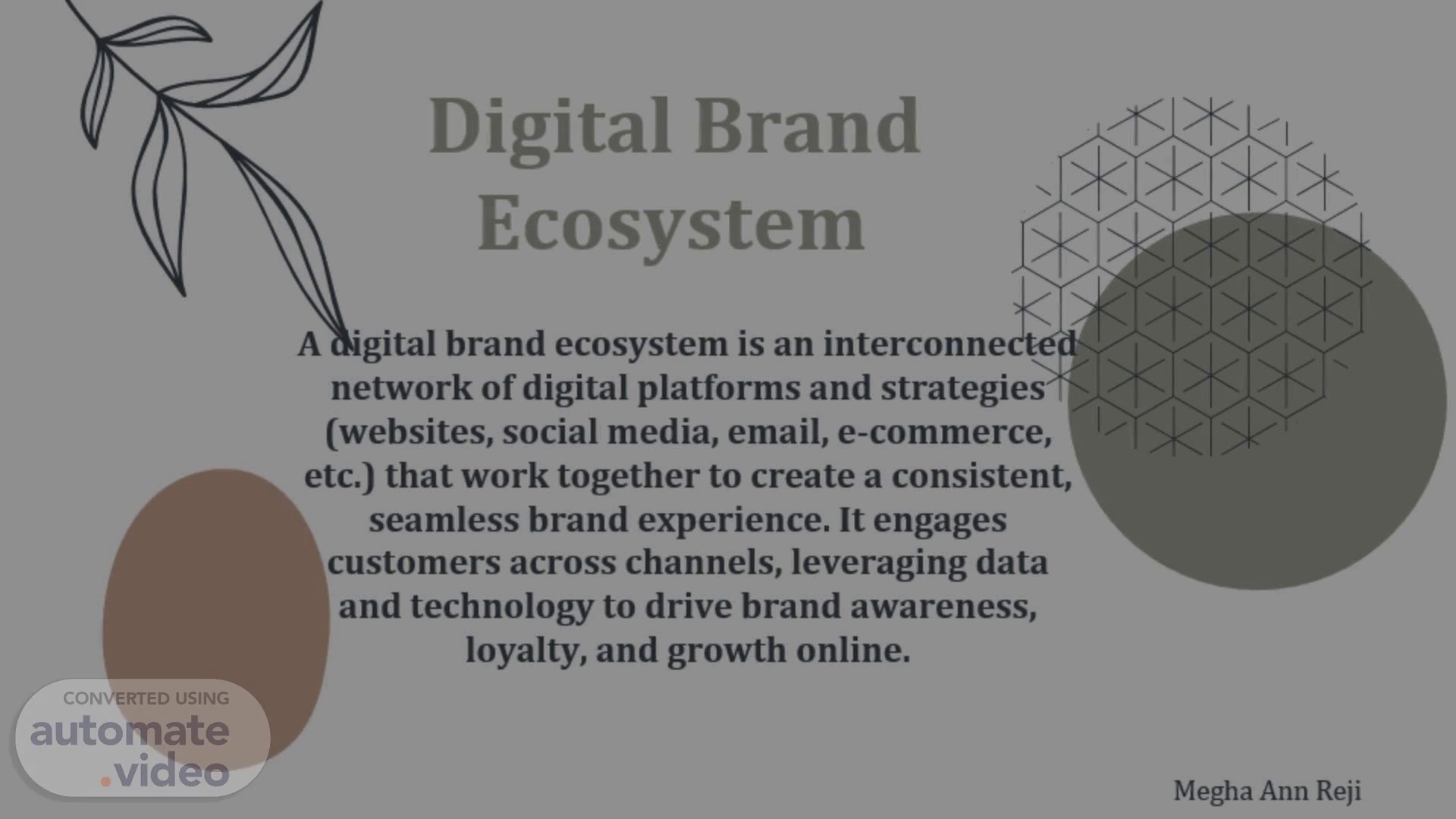Scene 1 (0s)
[Audio] Today, we're diving into the digital brand ecosystem and brand experience, understanding how these concepts interconnect to shape the modern brand landscape. A digital brand ecosystem is an interconnected network of digital platforms and strategies (websites, social media, email, e-commerce, et cetera) that work together to create a consistent, seamless brand experience. It engages customers across channels, leveraging data and technology to drive brand awareness, loyalty, and growth online. The digital brand ecosystem is a comprehensive framework that includes all the digital touchpoints and platforms through which a brand interacts with its audience. It's a dynamic, interconnected system where each digital element contributes to building and enhancing the brand's identity, reach, and customer engagement..
Scene 2 (57s)
[Audio] Key Element of Digital Brand Ecosystem. Key Element of Digital Brand Ecosystem.
Scene 3 (1m 6s)
[Audio] Website The core digital platform that serves as a central hub for brand communication, customer engagement, and transactions.
Scene 4 (1m 17s)
[Audio] Social Media Channels Platforms such as Facebook, Instagram, Twitter, LinkedIn, et cetera, where the brand interacts with its audience, shares content, and builds community..
Scene 5 (1m 30s)
[Audio] Content Marketing Blogs, videos, podcasts, infographics, and other types of content that engage users, build brand authority, and drive traffic..
Scene 6 (1m 43s)
[Audio] Search Engine Optimization (S-E-O--): Strategies to optimize digital content to rank higher in search engines, improving visibility and organic traffic..
Scene 7 (1m 56s)
[Audio] Email Marketing Personalized communication through email campaigns to nurture leads, engage customers, and promote products or services..
Scene 8 (2m 7s)
[Audio] 6. PAID ADVERTISING-: Digital ads on platforms like Google Ads, Facebook Ads, or display networks to target specific audiences and drive brand awareness or conversions. Paid advertising is any form of advertising that a marketer or a company pays for. 7. mobile PRESENCE-: It enable users to conduct essential transactions such as checking balances, viewing transaction history and transfer funds 8. E-COMMERCE-: Online platforms, marketplaces, or proprietary systems for selling products and services directly to consumers. 9. analytics A-N-D data INSIGHTS-: Tools like Google Analytics or other (B-I ) platforms to track, analyze, and optimize digital marketing efforts based on data..
Scene 9 (2m 58s)
[Audio] 10. user EXPERIENCE (U-X---) design -: Creating seamless, user-friendly experiences across digital touchpoints to enhance customer satisfaction and brand perception. 11. CUSTOMER support CHANNELS -: Digital solutions like chatbots, help desks, and social media to resolve customer issues and engage with them in real time..
Scene 10 (3m 27s)
[Audio] Brand experience Brand experience refers to the emotional and cognitive responses customers have during their interactions with a brand. It encompasses all the touchpoints through which consumers engage with a brand, influencing their perceptions, feelings, and loyalty..
Scene 11 (3m 46s)
[Audio] Key Elements of Brand Experience. Key Elements of Brand Experience.
Scene 12 (3m 55s)
[Audio] Core Elements Product/Service Brand Identity Customer Service Physical Environment Digital Experience.
Scene 13 (4m 4s)
[Audio] Creating a Memorable Consistency: Ensure a consistent brand experience across all touchpoints. Personalization: Tailor experiences to individual customer preferences and needs. Emotional Connection: Create an emotional connection with customers through storytelling and branding. Customer Feedback: Actively seek and address customer feedback to improve the experience. Innovation: Continuously strive to innovate and offer new and exciting experiences..
Scene 14 (4m 37s)
[Audio] Thank you. Thank you.
